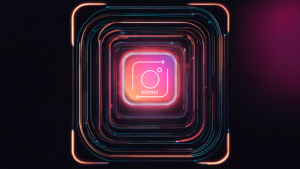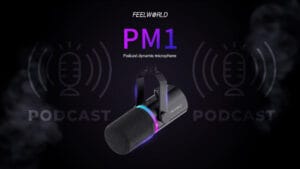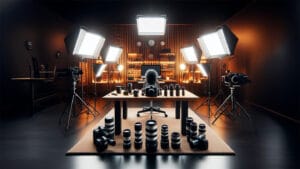
Last Updated: March 25, 2024
Shooting videos in low-light environments can be a challenge for many videographers. Lack of adequate lighting can result in dark, grainy and low-quality images, requiring special skill in camera settings, especially ISO (see my article on ISO: the villainous camera setting). However, with the advance of technology, cameras designed specifically to deal with low light conditions have emerged. In this article, I’m going to explore the 5 best low-light cameras for 2024, highlighting the main characteristics and features of each one.
The Importance of a Good Camera for Low-Light Environments
Before we dive into the best options available, it’s important to understand why a quality camera is essential for recording videos in low-light environments. Light is a fundamental element in creating sharp, vibrant images, and when there is a shortage of it, video quality can be compromised.
A camera designed for low-light environments is able to cope with challenging lighting conditions, allowing you to film brighter, sharper images with less noise. These cameras generally have larger sensors, higher ISO sensitivity and advanced image processing features.
Main resources to consider
When choosing a camera for low-light environments, there are a few key features to consider:
- ISO sensitivity: ISO sensitivity determines the camera’s ability to capture light in low light conditions. The higher the ISO value, the more sensitive to light the camera will be. Look for cameras with a wide ISO range and good image quality at higher ISO values.
- Sensor size: A larger sensor is able to capture more light, which results in better quality images in low light conditions. Cameras with full frame sensors or larger sensors tend to perform better in low light environments.
- Image stabilization: Image stabilization is essential to prevent images from becoming blurry due to movements of the camera or the operator’s hands. Look for cameras with optical image stabilization (OIS) or in-body image stabilization (IBIS) for smoother results.
- Dynamic Range: Dynamic range refers to the camera’s ability to capture detail in both the darkest and lightest areas of a scene. A good dynamic range is especially important in low-light environments, where there can be a significant contrast between the illuminated parts and the shadows.
- Video quality: In addition to low light capabilities, also check the camera’s overall video quality, including resolution, frame rate and recording options. These features are important to ensure that you get the results you want in any shooting situation.
Best cameras for low-light environments in 2023
Now that we understand the importance of the features mentioned above, let’s take a look at the best camera options for low-light environments in 2023:
| Camera | Maximum ISO | Sensor size | Image stabilization | Dynamic Range |
|---|---|---|---|---|
| Sony A7S III | 409600 | Full Frame | Body stabilization | 15+ stops |
| Sony FX3 | 409600 | Full Frame | Body stabilization | 15 stops |
| Panasonic Lumix S1H | 51200 | Full Frame | Body stabilization | 14 stops |
| Sony A7 III | 204800 | Full Frame | Body stabilization | 15 stops |
| Canon EOS R5 | 102400 | Full Frame | Body stabilization | 14 stops |
Sony A7S III
The Sony A7S III is one of the most popular cameras when it comes to low-light environments. With an impressive ISO range of up to 409600, this camera is able to capture clear, sharp images even in the most challenging lighting conditions. What’s more, its full-frame sensor and in-body stabilization guarantee exceptional image quality. It competes head-to-head with the latest Somy FX3 cinema line camera.
SEE SONY A7SIII FULL FEATURES (opens in a new tab)
Sony FX3
The Sony FX3 is part of Sony’s Cinema Series range of cameras, designed primarily for filmmakers and video professionals. With a 35mm Full Frame sensor, the FX3 offers an impressive dynamic range of 15 stops. This guarantees sharp, detailed images even in challenging lighting conditions. It is capable of recording in 4K resolution at up to 120fps, allowing you to create slow-motion videos and capture fast movements with exceptional quality. What’s more, its compact and lightweight design makes it an ideal choice for productions on the move, and the presence of in-body image stabilization (IBIS) helps achieve smooth videos. With professional audio inputs, internal ND filters and a variety of connectivity options, the Sony FX3 is a solid choice for high-quality video projects.
SEE SONY FX3’S FULL FEATURES (opens in a new tab)
Panasonic Lumix S1H
The Panasonic Lumix S1H is a powerful camera designed for professional videographers. With a maximum ISO of 51200, this camera offers good light sensitivity in low-light environments. Its full-frame sensor and in-body stabilization guarantee sharp, stable images in all situations. In addition, the Lumix S1H has a dynamic range of 14 stops, allowing details to be captured in every part of the scene.
SEE SONY S1H’S FULL FEATURES (opens in a new tab)
Sony A7 III
The Sony A7 III is a camera widely praised for its hybrid photo and video capability and for coping well with low-light environments. With a maximum ISO of 204800, this camera offers excellent light sensitivity. It was one of my first cameras and to this day I still use it for my professional work. Its full-frame sensor and in-body stabilization provide sharp, clear images in all lighting conditions. What’s more, the Sony A7 III has a dynamic range of 15 stops, allowing you to capture details in every part of the scene, from the darkest to the lightest areas.
SEE SONY A7III’S FULL FEATURES (opens in a new tab)
Canon EOS R5
The Canon EOS R5 is another powerful option for low-light environments. With a maximum ISO of 102400, this camera offers excellent light sensitivity. Its full-frame sensor and in-body stabilization help you get sharp, vibrant images in low-light conditions. In addition, the Canon EOS R5 has a dynamic range of 14 stops, allowing you to capture detail in both the darkest and lightest areas of the scene.
SEE THE CANON EOS R5’S FULL FEATURES (opens in a new tab)
Conclusion
When choosing a camera for low-light environments, it is essential to consider several features: ISO sensitivity, sensor size, image stabilization, dynamic range and video quality. The cameras mentioned in this article are some of the best options available in 2023 and with fantastic expectations for 2024.
Remember that equipment is only one part of the equation and it’s also important to master proper lighting techniques and exposure settings to get the best results. With the right combination of camera and technical know-how, you can create incredible videos even in low-light environments.
Make the most of the capabilities of the cameras mentioned in this article and exploit your creative skills to achieve impressive results in your next productions. This applies to both professional work and content creation. (Check out my latest article on Content Creator).
*(Some articles may have been written or structured with Artificial Intelligence, but they were all reviewed, improved and rewritten by a Human.)
**(May Contain Affiliate Links. It means I may earn a commission every time you click on one of the external links, but do not worry. There is no additional cost to you, on the contrary, Sometimes you can even have extra benefits and discounts. And you will be helping to maintain the blog. For more detailed information consult my Affiliate Disclosure Statement)






